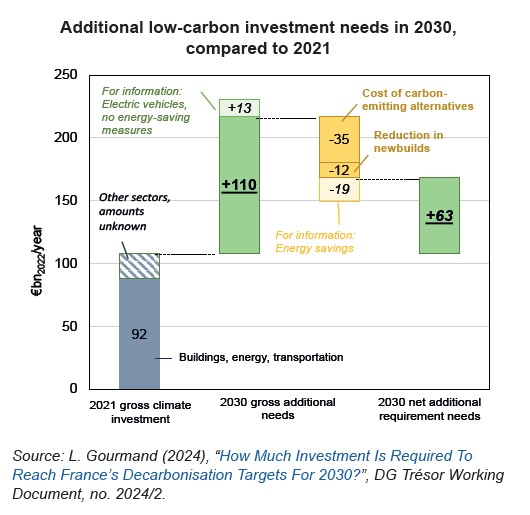How Much Investment Is Required To Reach France’s Decarbonisation Targets For 2030?
The literature provides various estimates of the additional investment in low-carbon items required in France to achieve decarbonisation targets, ranging from an extra €55 billion to €130 billion per year by 2030 – a two to five percentage point increase in GDP annually. This paper, applying a harmonised approach to these results and using supplementary figures, estimates an additional investment needs of €110 billion by 2030 compared to 2021, across the entire French economy.
A large-scale redirection of investment flows towards decarbonisation items is required for France to achieve its climate targets. Many estimates of the additional low-carbon investment needs have been made, ranging from €55 billion to €130 billion per year from now to 2030 (an additional two to five percentage points of GDP). Comparing these estimates is particularly challenging given the wide range of definitions, methods and scopes used.
Theoretically, minimising the costs of decarbonisation should be based on a comprehensive analysis of the abatement costs of each intervention across the entire economy. In practice, the investment needs are calculated by sector.
When applying a consistent methodology across sectors, the gross additional investment needs in low-carbon items (compared to 2021) are estimated at approximately €110 billion per year by 2030.
When deducting the lower investments in (i) carbon-emitting alternatives (e.g. only factoring in the additional cost of an electric vehicle compared to an internal combustion engine vehicle), and (ii) newbuilds, assuming reduced land take, the net additional investment needs would drop to €63 billion per year (see Chart opposite). This net requirement could be further reduced by the reduction of other fossil fuel investments (e.g. lower demand for new internal combustion engine vehicles) and by energy bill savings.
These estimates are subject to considerable uncertainties. In addition, the share of the effort between public and private economic agents is not addressed in this paper, as it will depend on the set of public policies implemented.
